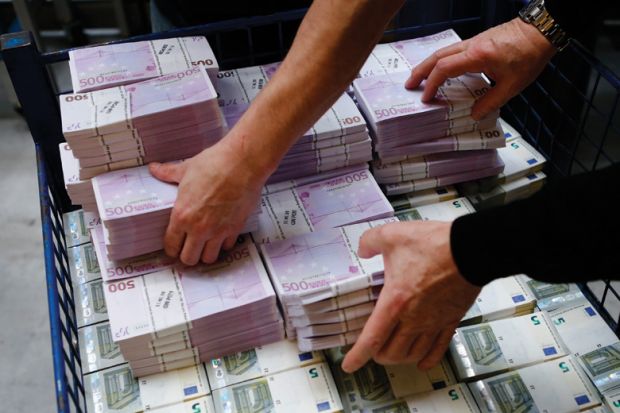The sovereign debt crisis in the eurozone, which has threatened the very survival of the euro, has still not been resolved, despite years of heated policy discussions on the matter and billions of euros of financial support provided. This excellent and timely book by Joseph Stiglitz, a Nobel laureate and former chief economist of the World Bank, explains the causes of the crisis and the policy response of the European Union, and specifically the eurozone, to it. He also puts forward three alternative solutions to the crisis that policymakers would do well to consider.
Stiglitz argues that the creation of the euro was a “fatal decision”, and the crisis, which began in 2009, ushered in “a lost decade” for parts of Europe. The construction of the economic and monetary union was informed by “bad economics”, that is, by a flawed neoliberal ideology that shaped flawed institutions and policies. It led to an “asymmetric” EMU, in which monetary policy was centralised at the eurozone level and conducted by the European Central Bank. However, economic policies mostly remained at the national level, even though the EU imposed limits on national fiscal policies. In the setting up of the EMU, monetary integration outpaced political integration, but economics and politics cannot be separated. If they are, the results are abysmal. In fact, according to Stiglitz, the euro augmented financial instability; triggered economic divergence instead of convergence; increased inequality across countries and within countries; and worsened the democratic deficit of the EU. The euro was supposed to be a means to an end, whereby monetary integration was to further political integration, but the reverse is happening. The “EU lost its compass” in dealing with the crisis, which became a morality play in which the only solution put forward was fiscal austerity.
Several new facts are presented here. Stiglitz outlines some oddities and mistakes of the programmes of the Troika, a triumvirate made up of the ECB, the European Commission and the International Monetary Fund, which discuss and monitor the conditional financial assistance provided to countries. The Troika programmes sometimes addressed issues that were trivial and even counterproductive, especially in Greece, where certain provisions concerned the labelling of milk and the size of loaves of bread (the expression relating to shifting chairs on the deck of the Titanic comes to mind). New light is also shed on important issues such as the ECB’s decision to force the hand of the Irish government in bailing out Irish banks. The result was that Irish taxpayers had to foot the bill, whereas if the banks had failed, shareholders and bondholders would have taken the hit. It was a fatal decision for the Republic of Ireland, which was pushed to the brink of bankruptcy and had to resort to external financial assistance.
This book has many merits: it deals with complex and technical matters in a way that is easy to follow, and that brings out the “politics” and political implications of some of the economic and technical decisions taken. It draws attention to the role of economic ideas, or rather ideologies, in the construction and management of the euro, considering the power configuration underpinning those ideas, in other words the interests at stake. It will be excellent reading for experts, but is also accessible to a broader audience. It is worth noting, too, that it is written in a lively, discursive format, and is a real pleasure to read. The only criticism I would make is that its criticisms are sometimes one-sided, and, at the very least, Stiglitz could have better contextualised the (wrong) choices made by policymakers prior to and during the crisis, so as to provide a more balanced assessment. The narrative focuses on “victims”, mostly the member states in the periphery of the eurozone, and “culprits”, namely the Troika (first and foremost the ECB, while the Commission does not appear much in the narrative) and Germany.
Let us start with the victims, or innocent bystanders. The mistakes that were made by periphery countries after the introduction of the euro and in the building-up of the crisis are somewhat brushed aside, or at the very least these countries get off lightly. For example, Stiglitz argues that structural reforms in the countries hit by the crisis were not really needed; instead, a reform of the structure of EMU was necessary. But clearly these countries had structural problems to address, even though doing so in the midst of the crisis was unwise. The national authorities in the countries hit by the crisis are often depicted as powerless to prevent the pre-crisis capital inflows, trade imbalances and real estate bubbles, which were followed by capital outflows and the bursting of the bubbles when the crisis began. However, these countries had options and instruments at their disposal to mitigate some of these problems. But in several instances the national authorities decided not to act, or actually worsened the problem.
In Spain, for example, local authorities actively promoted investment in construction (thus fuelling the real estate bubble) because it temporarily increased their tax revenues. Similarly, the Irish authorities let their banks expand excessively without adequate supervision. Yet the ECB – which prior to 2012 had no supervisory competences whatsoever – gets blamed for the policy failure in Ireland. In one of the few places of the book in which Stiglitz admits that mistakes were made by periphery countries, national political elites (mostly corrupted and inept politicians) are blamed. But politicians are embedded in national democracies, they are elected by voters in national elections, and they legitimately represent the country and the people who elected them.
The book is highly critical of the institutions and policies of the eurozone and presents much material to substantiate this critical view. However, some of the wrong decisions made by policymakers could have been better contextualised. Beginning with the construction of the EMU, it is not that many of the architects of the EMU did not know that further economic and political integration was needed for the EMU to work. To be fair, some German policymakers (including those at the Bundesbank) were very clear about this. But politically, it was impossible to set in place a more “symmetric” EMU. The ECB’s actions, which are critically assessed here (it is seen as a “credit collector” for Germany), were limited by the fact that it did not have a political authority standing behind it, unlike in the case of national central banks. The ECB and the national central banks in the euro system became heavily exposed financially in the crisis-stricken periphery. Had the ECB suffered major losses, there was no eurozone treasury to step in to foot the bill. In that respect, the final message of the book is clear and widely shared: we need “more Europe” with risk-sharing, fiscal transfers and more political integration (the solution that Stiglitz seems to prefer) or “less Europe” following an “amicable divorce” or a “flexible euro” – but the status quo is untenable.
According to Stiglitz, the failures of the euro reverberated in the recent UK referendum on membership of the EU, whose outcome was also a manifestation of the “evisceration of the middle class” and the discontent of an impoverished working class on both sides of the Atlantic. Therefore, some of the reforms advocated for the eurozone should extend to the entire EU, especially in the wake of Brexit, which is discussed in this book’s afterword (see below). Stiglitz warns against a “messy divorce”, and points out two extreme alternatives: a “real Brexit” with a hardline Europe refusing to grant the UK any special status and a “reform and remain” option, whereby Brexit never happens.
Lucia Quaglia is professor of political science, University of York. She is author of The European Union and Global Financial Regulation (2014) and co-author, with David Howarth, of The Political Economy of European Banking Union (2016).
The Euro and Its Threat to the Future of Europe
By Joseph Stiglitz
Allen Lane, 496pp, £20.00
ISBN 9780241258156
Published 16 August 2016
Spare the rod
From the afterword to Joseph Stiglitz’s The Euro and Its Threat to the Future of Europe
Europe’s response to the UK’s referendum was dominated by the same harsh response that greeted Greece’s June 2015 ballot-box rejection of its bailout package. Herman Van Rompuy, former EU Council President, expressed a widespread feeling when he said that Cameron’s decision to hold a referendum “was the worst policy decision in decades.” In so saying, he revealed a deep antipathy towards democratic accountability. Understandably so: as we have noted, in most of the cases in which voters have been directly turned to, they have rejected the euro, the European Union, and the European constitution. Moreover, polls at the time of Brexit showed that a majority of those in many European countries besides the UK had an unfavorable view of the EU (including Greece, France, and Spain).
The economic and political consequences of Brexit will, of course, depend a great deal on Europe’s response. Most assume that Europe will not “cut off its nose to spite its face.” It seems in the interests of everyone for there to be an “amicable divorce,” to work out the best economic relationship consistent with the democratic wishes and concerns of those on both sides of the Channel. The benefits of trade and economic integration are mutual, and if the EU takes seriously its belief that the closer the economic integration the better, that implies an attempt to make the closest ties possible under the circumstances. Anything the EU does to the UK to try to punish it would have an “equal and opposite effect,” hurting itself at least as much in the process. The fact that European stock markets were down markedly, and European banks were particularly hard hit at least suggests that Brexit was bad for Europe as well.
But Jean-Claude Juncker, the proud architect of Luxembourg’s massive corporate tax-avoidance schemes and now the head of the EU Commission, has taken a hard line – perhaps understandably, given that he may go down in history as the person on whose watch the dissolution of the EU began. His line is that Europe must be unrelenting in its punishment, and should offer little more than what the UK is guaranteed under normal global agreements, like the WTO, lest others join the rush to the exit. What a response! According to Juncker, Europe is not to be held together because of the benefits that accrue, benefits which far exceed the costs, the economic prosperity, the sense of solidarity, the pride in being a European. No, Europe is to be held together by threats and fear – of what would happen if a country leaves.
It was a perfect storm – a confluence of untoward circumstances – that led to what the elites around the world (and 48 percent of UK voters) viewed as a great disaster, a rip tide going against the mainstream current of globalization and closer economic integration. Historians will debate the what if – what if the leadership in Europe or the UK had done more to avoid the outcome which they almost all opposed? But that the referendum’s outcome will reshape the future of the EU, the eurozone, and globalization seems indisputable.
POSTSCRIPT:
Print headline: The currency that crushed a continent
Register to continue
Why register?
- Registration is free and only takes a moment
- Once registered, you can read 3 articles a month
- Sign up for our newsletter
Subscribe
Or subscribe for unlimited access to:
- Unlimited access to news, views, insights & reviews
- Digital editions
- Digital access to THE’s university and college rankings analysis
Already registered or a current subscriber? Login




